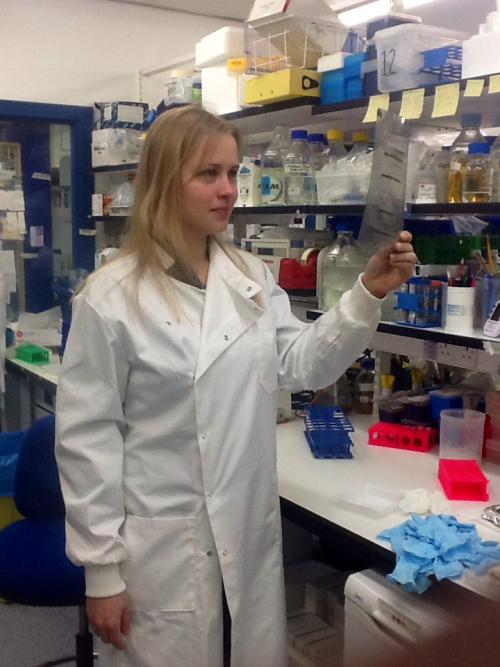
Agne discovers first substrate to be regulated by PINK1-dependent phosphorylation of Parkin at Serine65
Mutations in the PINK1 and Parkin genes are associated with early-onset Parkinson's disease. PINK1 encodes a mitochondrial-localised protein kinase whilst Parkin encodes a RING-IBR-RING E3 ubiquitin ligase. In 2012 a former PhD student of Miratul Muqit and Dario Alessi, Chandana Kondapalli, discovered that PINK1 can phosphorylate Parkin at Serine65 (Ser65), a highly conserved residue that lies within the N-terminal Ubl domain of Parkin. Furthermore, current PhD student, Agne Kazlauskaite, supervised by Dario and co-supervised by Miratul, had demonstrated that phosphorylation of Parkin at Ser65 led to activation of its E3 ligase activity as determined using a substrate-free autoubiquitylation assay.
An outstanding question that Agne wished to address was whether Ser65 phosphorylation of Parkin was critical for its ability to ubiquitylate substrates. Several lines of evidence indicated that physiological substrates of Parkin may reside in the mitochondria and Miro1, an atypical mitochondrial GTPase, has recently emerged as a candidate substrate for Parkin.
Agne developed a novel assay of E3 ligase activity using full-length untagged Parkin and Miro1 and was able to demonstrate that Parkin could efficiently ubiquitylate Miro1 only upon phosphorylation by wild-type PINK1. Importantly she showed that Miro1 ubiquitylation was abolished using kinase-inactive PINK1 or a non-phosphorylatable Ser65Ala point of mutant of Parkin. Furthermore, in collaboration with Van Kelly, a PhD student in Patrick Pedrioli's lab, she was able to map the sites of Miro1 ubiquitylation to highly conserved lysine residues, 153, 230, 235, 330 and 572. Agne next developed an E2-ubiquitin discharge assay to assess Parkin activity and found that Parkin could stimulate robust discharge of ubiquitin-loaded E2 only after phosphorylation of Parkin by wild-type PINK1 and not by the Ser65Ala Parkin mutant. Agne next deployed her assays to investigate the effect of Parkinson's disease-associated point mutants of Parkin. Her analysis revealed that the majority of mutants tested led to disruption of Parkin E3 ligase activity including the catalytic cysteine mutant, Cys431Phe. However, Agne also identified mutants that increased Parkin E3 ligase activity as well as mutants that did not significantly alter activity.
Agne's studies suggest that phosphorylation of Parkin at Ser65 is critical for its activation. The assays she has developed will be important to uncover new insights into Parkin biology as well as aid in the development of screens to identify Parkin activators that may have therapeutic potential in Parkinson's.
To read a copy of Agne's paper published in Open Biology, click here
An outstanding question that Agne wished to address was whether Ser65 phosphorylation of Parkin was critical for its ability to ubiquitylate substrates. Several lines of evidence indicated that physiological substrates of Parkin may reside in the mitochondria and Miro1, an atypical mitochondrial GTPase, has recently emerged as a candidate substrate for Parkin.
Agne developed a novel assay of E3 ligase activity using full-length untagged Parkin and Miro1 and was able to demonstrate that Parkin could efficiently ubiquitylate Miro1 only upon phosphorylation by wild-type PINK1. Importantly she showed that Miro1 ubiquitylation was abolished using kinase-inactive PINK1 or a non-phosphorylatable Ser65Ala point of mutant of Parkin. Furthermore, in collaboration with Van Kelly, a PhD student in Patrick Pedrioli's lab, she was able to map the sites of Miro1 ubiquitylation to highly conserved lysine residues, 153, 230, 235, 330 and 572. Agne next developed an E2-ubiquitin discharge assay to assess Parkin activity and found that Parkin could stimulate robust discharge of ubiquitin-loaded E2 only after phosphorylation of Parkin by wild-type PINK1 and not by the Ser65Ala Parkin mutant. Agne next deployed her assays to investigate the effect of Parkinson's disease-associated point mutants of Parkin. Her analysis revealed that the majority of mutants tested led to disruption of Parkin E3 ligase activity including the catalytic cysteine mutant, Cys431Phe. However, Agne also identified mutants that increased Parkin E3 ligase activity as well as mutants that did not significantly alter activity.
Agne's studies suggest that phosphorylation of Parkin at Ser65 is critical for its activation. The assays she has developed will be important to uncover new insights into Parkin biology as well as aid in the development of screens to identify Parkin activators that may have therapeutic potential in Parkinson's.
To read a copy of Agne's paper published in Open Biology, click here

